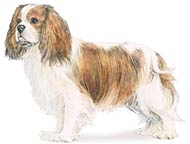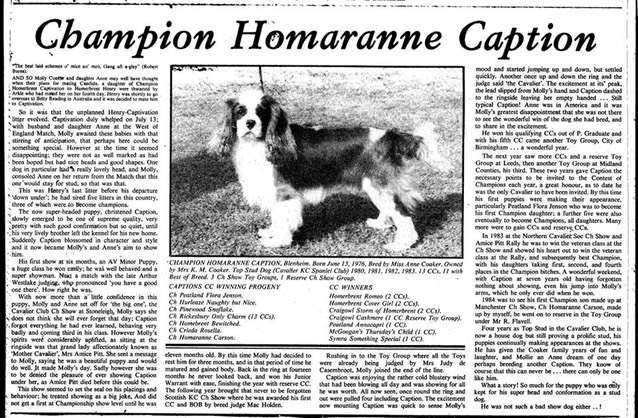
This is the written standard (see below) that is used by all AKC Judges when evaluating dogs at a dog show. Each dog is compared to the standard and then to the other dogs in the ring.
Reputable breeders can recite the standard in their sleep. Study groups and Judges' seminars are hosted where the fine points of the Cavalier standard are discussed in detail. Breeders evaluate their girls and use the standard to determine what stud dogs would best enhance the girl that they are breeding.
Often you will hear breeders say things like, her tail set is too low, her eyes are not large enough, the markings are not correct or he is going to be too big. Many times for boy is both testicles have not descended or the bite (teeth alignment) is off. None of these things will affect the life of a companion dog, but they would not see a placement in the show ring.
In reverse, what we see in an 8-12 weeks in the puppy can correct itself later in life. It is a breeder's biggest fear of placing the pick puppy in to a companion home. One such Cairn Terrier back in the 1990's was placed accidently as a pet. The breeder begged and was allowed to borrow on a few show weekends the dog to show. Unbelievably, he obtained his championship in one weekend and had multiple group wins and a specialty win shortly afterwards. He was then retired and went home to chase balls and drive the kids to school.
Ask your perspective breeder what qualities their mother and sire of the perspective puppy exemplify compared to the standard. Ask why they are selling that puppy. If they don't know and can't discuss the standard, this is a huge clue that they are breeding for profit and not for the betterment of the breed.
Take a minute and read the standard. Afterwards if you need more clarification the CKCSC National club has the Judges's Education aid online.
AKC Cavalier King Charles Spaniel Breed Standard
General Appearance
The Cavalier King Charles Spaniel is an active, graceful, well-balanced toy spaniel, very gay and free in action; fearless and sporting in character, yet at the same time gentle and affectionate. It is this typical gay temperament, combined with true elegance and royal appearance which are of paramount importance in the breed. Natural appearance with no trimming, sculpting or artificial alteration is essential to breed type.
Size, Proportion, Substance
Size - Height 12 to 13 inches at the withers; weight proportionate to height, between 13 and 18 pounds. A small, well balanced dog within these weights is desirable, but these are ideal heights and weights and slight variations are permissible. Proportion - The body approaches squareness, yet if measured from point of shoulder to point of buttock, is slightly longer than the height at the withers. The height from the withers to the elbow is approximately equal to the height from the elbow to the ground. Substance - Bone moderate in proportion to size. Weedy and coarse specimens are to be equally penalized.
Head Proportionate to size of dog, appearing neither too large nor too small for the body. Expression - The sweet, gentle, melting expression is an important breed characteristic. Eyes - Large, round, but not prominent and set well apart; color a warm, very dark brown; giving a lustrous, limpid look. Rims dark. There should be cushioning under the eyes which contributes to the soft expression. Faults - small, almond-shaped, prominent, or light eyes; white surrounding ring. Ears - Set high, but not close, on top of the head. Leather long with plenty of feathering and wide enough so that when the dog is alert, the ears fan slightly forward to frame the face. Skull - Slightly rounded, but without dome or peak; it should appear flat because of the high placement of the ears. Stop is moderate, neither filled nor deep. Muzzle - Full muzzle slightly tapered. Length from base of stop to tip of nose about 1½ inches. Face well filled below eyes. Any tendency towards snipiness undesirable. Nose pigment uniformly black without flesh marks and nostrils well developed. Lips well developed but not pendulous giving a clean finish. Faults - Sharp or pointed muzzles. Bite - A perfect, regular and complete scissors bite is preferred, i.e. the upper teeth closely overlapping the lower teeth and set square into the jaws. Faults - undershot bite, weak or crooked teeth, crooked jaws.
Neck, Topline, Body
Neck - Fairly long, without throatiness, well enough muscled to form a slight arch at the crest. Set smoothly into nicely sloping shoulders to give an elegant look. Topline - Level both when moving and standing. Body - Short-coupled with ribs well spring but not barrelled. Chest moderately deep, extending to elbows allowing ample heart room. Slightly less body at the flank than at the last rib, but with no tucked-up appearance. Tail - Well set on, carried happily but never much above the level of the back, and in constant characteristic motion when the dog is in action. Docking is optional. If docked, no more than one third to be removed.
Forequarters
Shoulders well laid back. Forelegs straight and well under the dog with elbows close to the sides. Pasterns strong and feet compact with well-cushioned pads. Dewclaws may be removed.
Hindquarters
The hindquarters construction should come down from a good broad pelvis,
moderately muscled; stifles well turned and hocks well let down. The hindlegs
when viewed from the rear should parallel each other from hock to heel.
Faults - Cow or sickle hocks.
Coat
Of moderate length, silky, free from curl. Slight wave permissible. Feathering on ears, chest, legs and tail should be long, and the feathering on the feet is a feature of the breed. No trimming of the dog is permitted. Specimens where the coat has been altered by trimming, clipping, or by artificial means shall be so severly penalized as to be effectively eliminated from competition. Hair growing between the pads on the underside of the feet may be trimmed.
Color
Blenheim - Rich chestnut markings well broken up on a clear, pearly white ground. The ears must be chestnut and the color evenly spaced on the head and surrounding both eyes, with a white blaze between the eyes and ears, in the center of which may be the lozenge or "Blenheim spot." The lozenge is a unique and desirable, though not essential, characteristic of the Blenheim.
Tricolor - Jet black markings well broken up on a clear, pearly white ground. The ears must be black and the color evenly spaced on the head and surrounding both eyes, with a white blaze between the eyes. Rich tan markings over the eyes, on cheeks, inside ears and on underside of tail.
Ruby - Whole-colored rich red.
Black and Tan - Jet black with rich, bright tan markings over eyes, on cheeks, inside ears, on chest, legs, and on underside of tail. Faults - Heavy ticking on Blenheims or Tricolors, white marks on Rubies or Black and Tans.
Gait
Free moving and elegant in action, with good reach in front and sound, driving rear action. When viewed from the side, the movement exhibits a good length of stride, and viewed from front and rear it is straight and true, resulting from straight-boned fronts and properly made and muscled hindquarters.
Temperament
Gay, friendly, non-aggressive with no tendency towards nervousness or
shyness. Bad temper, shyness, and meanness are not to be tolerated and
are to be severely penalized as to effectively remove the specimen from
competition.
Approved Date: January 10, 1995
Effective Date: April 30, 1995
